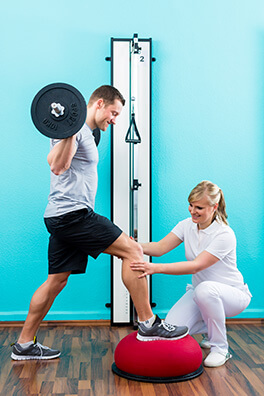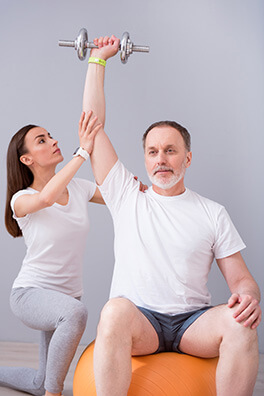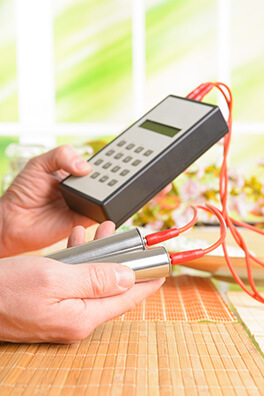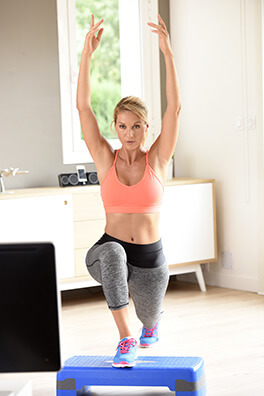Our Services
Functional Restoration San Diego offers cost-effective treatment that improves mobility, improves the management of pain, reduces the need for surgery and prescription drugs, and allows patients to participate in a recovery plan designed for their specific needs.

Physical Therapy
What is Physical Therapy? Physical Therapy is the art and science of healing your body’s injuries through non-invasive treatments. FRSD PT Treatments include: exercises, stretches, endurance training, modifying how to move, postural re-training and functional tasks. A Doctor of Physical Therapy will conduct a detailed evaluation and provide an individual Plan-Of-Care to treat the whole body.
At FRSD we are outcome driven and solution focused. As research suggests for chronic pain, those who take an active role in physical therapy have the most success. Our group model focuses on encouragement and motivation not only by our team but also by fellow program participant members.
While attending the program, re-assessments of strength, range of motion and functional tasks will be conducted weekly to provide the most up-to-date treatment interventions. Re-Assessments will also include functional tasks based physical therapy. These tasks include transferring weighted box from floor to waist level, and waist to shoulder level as well as moving with weighted items. Week after week, participants are able to see visually how they are progressing from a functional standpoint in their chronic pain survivor journey.
Group Model
This program is based on a group model. You have been experiencing the problems and challenges of your pain for a while and you may have felt alone or misunderstood at times. Here at FRSD, we believe in providing a group model so that participants can learn about and process their pain with other participants who are going through many of the same problems and challenges.
A group model allows the participants to be part of a bigger team of both participants and providers. We hope to help you achieve a sense of mastery over your communication about your pain by fostering an environment that encourages vocal self-exploration and processing. Though it is not demanded, we encourage you to participate in the group discussions so that you can increase the benefit from the educational and therapeutic process.


Movement Instruction
Movement instruction provides proper body mechanics to perform tasks and prevent injury. We will teach program participants to bend at the hips and knees when lifting objects instead of using your spine. Participants will learn to keep arms tucked close to their body when moving objects to maintain core stability.
Individuals with chronic pain often walk with guarded walking patterns. The way we walk, or the gait strategy we use, often describes the source of the impairment. Our FRP PT Team will teach the best way to walk and move to improve endurance and overall functional capacity. Many functional tasks include walking while pushing, pulling and carrying weight. This may disrupt gait strategy and push the body to adapt and recruit supportive muscle groups. The body will self-correct over time to improve the way we move. We focus on these adaptations in therapeutic exercises to restore strength to where program participants may need it most.
Program participants take new body mechanics home each day to perform activities of daily living with increased independence. The mechanics provide a sense of safety and security to be more physically active and generate more energy as healing takes place over time.
Acceptance & Commitment Therapy (ACT)
Acceptance and Commitment Therapy is a powerful therapeutic approach based on cutting-edge research into how the human mind works. It has been clinically proven to be successful for treating a wide range of psychological problems. The unusual name of this therapy comes from one of its key themes: Learn how to accept those things that are out of your control, and commit to changing those things that can be changed to make your life better. This treatment active. Hence the name-ACT. It’s not a merely a talk therapy. It’s a do therapy. It’s a therapy in which you actively learn new skills to improve your quality of life.
When you consider the demanding nature of chronic pain, it is easy to see why so many patients dealing with chronic pain find themselves in the chronic pain cycle described above. Most pain patients distance themselves from leisure, social, or even family and loved ones.
Avoidance can also be seen in their disengagement from exercise, outdoor activities, or spiritual practices. Avoidance sometimes comes in the form of medication or treatment. Pain medication may have an initial benefit, but eventually the medication’s benefit decreases and the individual is left feeling dependent and still in pain.


FRSD Biofeedback Center
The FRSD Biofeedback Center provides the FRP participants an environment to practice mindfulness and breathing techniques in a private and safe environment. FRSD providers will help you learn the basics of breathing and relaxation and also teach you how to improve relaxation with the use of Biofeedback.
So what is Biofeedback? Chances are you have used biofeedback already. Have you ever checked your temperature when you were sick or weighed yourself while you were on a diet? If you have, then you have participated in biofeedback. In both cases, you were provided with information about your biological system.
Armed with this information, you could take steps to improve your condition. For example, when you learned that you were running a fever, you could choose to go to bed, rest up and drink plenty of fluids. When you learned that you were losing weight at a moderate pace, you could choose to treat yourself to a small treat.
Heart Rate Variability (HRV)
The type of biofeedback we use at FRSD is known as HRV Biofeedback. HRV stands for Heart Rate Variability. There are many different types of biofeedback. All biofeedback monitors various bodily systems such as breath, temperature, and even pupil dilation.
HRV biofeedback monitors your heart rate changes to determine how effectively your breathing and relaxation strategies help you manage your stress, pain, and overall emotional or psychological discomfort. Pain is impacted by many things including biological, psychological, and social (Biopsychosocial) factors.
HRV biofeedback helps patient’s improve their stress and pain management by controlling their heart rate which is effected by biopsychosocial factors. Biofeedback may be used to improve performance and the physiological changes that often occur in conjunction with changes to thoughts, emotions, and behavior. Eventually, new and improved breathing may be maintained without the use of HRV and any other biofeedback equipment.
While in this program you will be completing a weekly evaluation addressing several areas. The tables below will help you and the treatment team better understand your progress and achievements along the way. The results are used to both show you how well you are doing and also to help us get authorization for more days in the program.
Individualized Home Exercise Program
Individualized Home Exercise Programs (HEP) will be provided to each participant toward the end of the program. A Home Exercise Program is a set of exercises and stretches you perform independently that help you maintain and improve your overall function.
Program participants will master this program in the clinic with the Physical Therapist. Functional Restoration self-correcting techniques promote self-motivating and thereby benefit patients far beyond the duration of our program.


